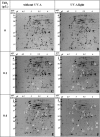TiO2 photocatalysis damages lipids and proteins in Escherichia coli
- PMID: 24532071
- PMCID: PMC3993174
- DOI: 10.1128/AEM.03995-13
TiO2 photocatalysis damages lipids and proteins in Escherichia coli
Abstract
This study investigates the mechanisms of UV-A (315 to 400 nm) photocatalysis with titanium dioxide (TiO2) applied to the degradation of Escherichia coli and their effects on two key cellular components: lipids and proteins. The impact of TiO2 photocatalysis on E. coli survival was monitored by counting on agar plate and by assessing lipid peroxidation and performing proteomic analysis. We observed through malondialdehyde quantification that lipid peroxidation occurred during the photocatalytic process, and the addition of superoxide dismutase, which acts as a scavenger of the superoxide anion radical (O2·(-)), inhibited this effect by half, showing us that O2·(-) radicals participate in the photocatalytic antimicrobial effect. Qualitative analysis using two-dimensional electrophoresis allowed selection of proteins for which spot modifications were observed during the applied treatments. Two-dimensional electrophoresis highlighted that among the selected protein spots, 7 and 19 spots had already disappeared in the dark in the presence of 0.1 g/liter and 0.4 g/liter TiO2, respectively, which is accounted for by the cytotoxic effect of TiO2. Exposure to 30 min of UV-A radiation in the presence of 0.1 g/liter and 0.4 g/liter TiO2 increased the numbers of missing spots to 14 and 22, respectively. The proteins affected by photocatalytic oxidation were strongly heterogeneous in terms of location and functional category. We identified several porins, proteins implicated in stress response, in transport, and in bacterial metabolism. This study reveals the simultaneous effects of O2·(-) on lipid peroxidation and on the proteome during photocatalytic treatment and therefore contributes to a better understanding of molecular mechanisms in antibacterial photocatalytic treatment.
Figures

 , in the dark;
, in the dark;  , under UV-A irradiation. * (P < 0.05), ** (P < 0.01), *** (P < 0.001), and **** (P < 0.0001) indicate the significance of the difference between sample means, obtained using Student's t test.
, under UV-A irradiation. * (P < 0.05), ** (P < 0.01), *** (P < 0.001), and **** (P < 0.0001) indicate the significance of the difference between sample means, obtained using Student's t test.
 , in the dark;
, in the dark;  , under UV-A irradiation. ** (P < 0.01), **** (P < 0.0001), and ns (not significant) indicate the significance of the difference between sample means obtained with Student's t test.
, under UV-A irradiation. ** (P < 0.01), **** (P < 0.0001), and ns (not significant) indicate the significance of the difference between sample means obtained with Student's t test.
Similar articles
-
On the use of capillary cytometry for assessing the bactericidal effect of TiO2. Identification and involvement of reactive oxygen species.Photochem Photobiol Sci. 2013 Apr;12(4):610-20. doi: 10.1039/c2pp25189b. Photochem Photobiol Sci. 2013. PMID: 22972374
-
Efficacy of UV-TiO2 photocatalysis technology for inactivation of Escherichia coli K12 on the surface of blueberries and a model agar matrix and the influence of surface characteristics.Food Microbiol. 2018 Dec;76:526-532. doi: 10.1016/j.fm.2018.07.015. Epub 2018 Jul 30. Food Microbiol. 2018. PMID: 30166184
-
Bactericidal efficiency and mode of action: a comparative study of photochemistry and photocatalysis.Water Res. 2012 Jun 15;46(10):3208-18. doi: 10.1016/j.watres.2012.03.019. Epub 2012 Mar 17. Water Res. 2012. PMID: 22503496
-
Ferrate(VI) enhanced photocatalytic oxidation of pollutants in aqueous TiO2 suspensions.Environ Sci Pollut Res Int. 2010 Feb;17(2):453-61. doi: 10.1007/s11356-009-0170-0. Epub 2009 Jun 3. Environ Sci Pollut Res Int. 2010. PMID: 19495821 Review.
-
UV-absorption--the primary process in photocatalysis and some practical consequences.Molecules. 2014 Nov 6;19(11):18192-214. doi: 10.3390/molecules191118192. Molecules. 2014. PMID: 25383755 Free PMC article. Review.
Cited by
-
Bioengineering Approaches to Fight against Orthopedic Biomaterials Related-Infections.Int J Mol Sci. 2022 Oct 1;23(19):11658. doi: 10.3390/ijms231911658. Int J Mol Sci. 2022. PMID: 36232956 Free PMC article. Review.
-
Novel Antibacterial Metals as Food Contact Materials: A Review.Materials (Basel). 2023 Apr 11;16(8):3029. doi: 10.3390/ma16083029. Materials (Basel). 2023. PMID: 37109867 Free PMC article. Review.
-
Photocatalytic Bacterial Destruction and Mineralization by TiO2-Based Photocatalysts: A Mini Review.Molecules. 2024 May 9;29(10):2221. doi: 10.3390/molecules29102221. Molecules. 2024. PMID: 38792082 Free PMC article. Review.
-
Treatment of Dairy Industry Wastewater and Crop Irrigation Water Using AgBr-Coupled Photocatalysts.Nanomaterials (Basel). 2025 Jun 2;15(11):848. doi: 10.3390/nano15110848. Nanomaterials (Basel). 2025. PMID: 40497896 Free PMC article.
-
Photoreactive Coating Material as an Effective and Durable Antimicrobial Composite in Reducing Bacterial Load on Surfaces in Livestock.Biomedicines. 2022 Sep 17;10(9):2312. doi: 10.3390/biomedicines10092312. Biomedicines. 2022. PMID: 36140413 Free PMC article.
References
-
- Wolska KI, Grzes K, Kurek A. 2012. Synergy between novel antimicrobials and conventional antibiotics or bacteriocins. Pol. J. Microbiol. 61:95–104 - PubMed
Publication types
MeSH terms
Substances
LinkOut - more resources
Full Text Sources
Other Literature Sources

